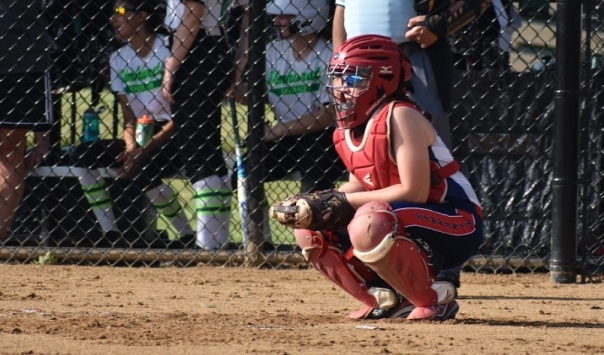The Sneaky Pick Play at First

Picking off a runner at first is a tough play for a right-handed catcher – especially one who isn’t comfortable or doesn’t have the arm strength to throw quickly from her knees.
By the time the catcher gets up, spins toward first, pulls her arm back and makes the throw there probably isn’t anyone in the tri-county area who doesn’t know what she’s doing. Even if she does throw from her knees, the amount of movement that is required to make a strong, accurate throw will likely be a pretty big tipoff to all but the sleepiest of base runners. And any first base coach who doesn’t pick up on what she’s doing should be relegated to the bench immediately.
There is another way to approach it, however, that can help disguise what the catcher is doing until it’s too late. It’s designed for when you have multiple runners on base and need an out to get out of an inning.
First let’s set up the situation. Preferably you have bases loaded and two outs, although you can run this play with runners on first and second and one or two outs.
What you’re looking for is the runner on first who figures no one cares about her (poor girl!). She takes a big lead, kind of stands there nonchalantly while the catcher has the ball, and then when the catcher goes to throw it back to the pitcher the runner drops her head and walks back to the base. Bonus if the first base coach is hyper-focused on seeing whether the girl on third will score soon.
When the pitch is delivered, the catcher catches it and runs out to chase the runner on third back to the base. Once the runner on third looks like she is committed to going back, the catcher turns to throw the ball to the pitcher, just like normal.
As she pulls her arm back, however, she uses her eyes to sneak a peek at the runner on first. If she is walking back not paying attention the catcher adjusts her shoulders without looking and fires to first instead.
By the time the first base coach and runner react, the ball is already in the first baseman’s hands for an easy tag. Inning over.
Sounds simple, right? It’s not. It actually requires a fair amount of practice because the catcher can’t do anything to indicate that she will be throwing to first until the ball is close to leaving her hand.
For example, this is a no-look throw. The catcher’s head can’t turn toward first at all, which is a tougher habit to break than you might think. It takes some discipline to keep her head pointed toward the pitcher, even if her eyes are looking toward first.
The catcher must also be able to throw with a decent amount of velocity without lining her entire body up toward the target. In effect she is stepping to her left and then throwing about 30 degrees to her right. That takes some practice so she doesn’t throw it into right field – or the parking lot!
Finally, the catcher has to be casual about the throw until it’s time to actually bring the ball forward in the throwing motion. She has to pull her arm back as if to throw it 20-30 feet to a waiting pitcher. Any sudden movement until the ball is about to be launched could again give it away.
Of course the first baseman has to be aware the play is happening, and can’t be fooled by the motion being used to fool the runner. She just has to accept that the ball could be coming while remaining more casual as well. If she looks like she’s ready for a play it could spoil the whole thing.
So yes, there’s a lot that could go wrong. Instead of getting the third out you could end up giving up a couple of runs and putting another runner in scoring position.
That’s why it requires a lot of practice, and a lot of confidence not just on the part of the catcher and first baseman but also the coach to allow this play to occur.
When it works, though, it’s a thing of beauty. And it really takes the wind out of the sails of the opposing team because A) it took them out of a good scoring opportunity where the pressure was on the defense and B) it made them look foolish.
Even if you never use it in a game, this is the type of play that can spark a defense and get them feeling good. But if you do use it, and you execute it properly, it’s something everyone on the team, and everyone in the stands, will remember for a long time to come.
So if you’re feeling adventurous or just want to give your team a little extra energy, give this sneaky little play a try. It could be the thing that turns a game around for you.
Posted on July 24, 2020, in Catching and tagged catcher, first base, pick play, secret plays, sneaky, third out. Bookmark the permalink. Leave a comment.




Leave a comment
Comments 0